Promenade, Begin Museum, Free Evening
Day Seven - Sunday July 9th -  - Yom
Ree-shon
- Yom
Ree-shon
 The
breakfasts here in Israel are absolutely abundant. There must be
about 60-70 different things to choose from. Various cheeses,
olives, chumas, fish, salads, etc. I think that I'm starting to just
want something simple for a change, like Raisin Bran! The
breakfasts here in Israel are absolutely abundant. There must be
about 60-70 different things to choose from. Various cheeses,
olives, chumas, fish, salads, etc. I think that I'm starting to just
want something simple for a change, like Raisin Bran!
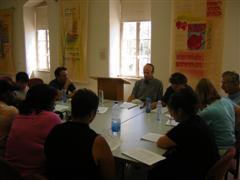 After breakfast we started the day at the Fuchsberg Center for conservative
Judaism where we studied a little bit of Talmud. Specifically the concept of religious arrogance. The Fuchsberg Center has recently acquired some adjacent land where they have renovated some old, and built some new, facilities. After breakfast we started the day at the Fuchsberg Center for conservative
Judaism where we studied a little bit of Talmud. Specifically the concept of religious arrogance. The Fuchsberg Center has recently acquired some adjacent land where they have renovated some old, and built some new, facilities.
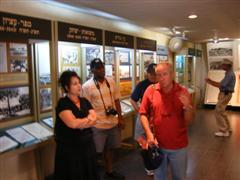 We then headed south of Jerusalem, towards Efrat and Gush Etzion also in the direction of Bethlehem. We studied the history of four Kibuttzim that were settled in the early 20th century, at first in 1927 then again in 1936, then later in 1947 Kfar Etzion, Masuot Yitzchak, Revarim, and Ein Tzurim. The area they were in was very hostile, and it was difficult to settle. Three times they settled, and three times it was destroyed or removed. They resettled the land in 1967. Rabbi Creditor shared a story of some of the settlers that he met when he traveled here in 1968, where he had asked some of the settlers why are you here on this land as hostile as it is, and as difficult as it is to settle. They said, “that is the blood of our fathers on this land.” They did not move from the land, and those Kibbutzim are still there today. We then headed south of Jerusalem, towards Efrat and Gush Etzion also in the direction of Bethlehem. We studied the history of four Kibuttzim that were settled in the early 20th century, at first in 1927 then again in 1936, then later in 1947 Kfar Etzion, Masuot Yitzchak, Revarim, and Ein Tzurim. The area they were in was very hostile, and it was difficult to settle. Three times they settled, and three times it was destroyed or removed. They resettled the land in 1967. Rabbi Creditor shared a story of some of the settlers that he met when he traveled here in 1968, where he had asked some of the settlers why are you here on this land as hostile as it is, and as difficult as it is to settle. They said, “that is the blood of our fathers on this land.” They did not move from the land, and those Kibbutzim are still there today.
 We stopped at the “lone tree” atop Gush Etzion which still stands today as a beautiful oak tree. The lone tree was the landmark that would mark the area of Gush Etzion from far reaching distances. As one looks around from the lone tree, you can see the other hills which contained hostile Jordanian forces. We stopped at the “lone tree” atop Gush Etzion which still stands today as a beautiful oak tree. The lone tree was the landmark that would mark the area of Gush Etzion from far reaching distances. As one looks around from the lone tree, you can see the other hills which contained hostile Jordanian forces.
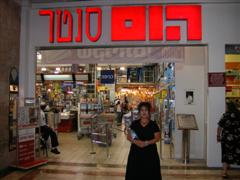 We then drove through Efrat which had many rocky hills, many slated for later development. We then stopped off at the Jerusalem mall. This mall is located in a very highly industrialized area. We ate lunch there in a food court, we visited the home center (like Home Depot, it’s Hebrew spelling phonetically spells Home Center!) and took a few snapshots, I had some kind of calzone, and I also ordered a burger from Burger King just to see what it tasted like, it tasted like Burger King! We then drove through Efrat which had many rocky hills, many slated for later development. We then stopped off at the Jerusalem mall. This mall is located in a very highly industrialized area. We ate lunch there in a food court, we visited the home center (like Home Depot, it’s Hebrew spelling phonetically spells Home Center!) and took a few snapshots, I had some kind of calzone, and I also ordered a burger from Burger King just to see what it tasted like, it tasted like Burger King!
 The bus that we rode in today, had real bullet proof glass to protect us as in the past during the intifada, Palestinian snipers would take shots at the tour buses. Of course, at the moment this is not the case, still it’s nice to have extra protection. The bus that we rode in today, had real bullet proof glass to protect us as in the past during the intifada, Palestinian snipers would take shots at the tour buses. Of course, at the moment this is not the case, still it’s nice to have extra protection.
I wanted to take a snapshot of the guard on the way in, he remarked “no pictures” to which I replied with a smile, “how did you know that I wanted to take a picture of YOU?” – there was a pretty girl standing right next
him, I think she got a kick out of it!
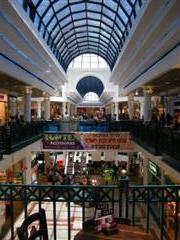 The mall had Arabs and Jews shopping side by side. If I wasn’t wearing a kippa you wouldn’t know that I was Jewish, if the Arab women weren’t wearing veils you wouldn’t know they were Arab. The mall had Arabs and Jews shopping side by side. If I wasn’t wearing a kippa you wouldn’t know that I was Jewish, if the Arab women weren’t wearing veils you wouldn’t know they were Arab.
Rabbi Creditor explained how the cycle of forestation, leaves, compost, animals (fertilization) and soil had been eroded away from the hills with rocks on them over the thousands of years. Almost all hills have rocks on them and look somewhat lacking of farmable soil. The JNF program of planting trees in Israel is critical to reestablishing this cycle as the trees’ root system also prevents the soil from being washed away.
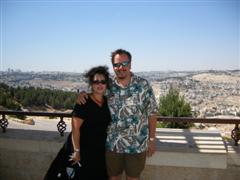 We then traveled to a location called Ramon Hanotzif where we walked along the Goldman promenade, where we observed Jerusalem from the Southern side, this was a magnificent view as it galvanized our Jerusalem experience from a geographical perspective. This view overlooked the valley of Abu Tor. The view was absolutely spectacular!!! Some of the villages that we viewed from here where Arab, some Jewish. We spoke of the aqua duct that King Herod built, we viewed a section of the aqua duct that passed through some natural bedrock, where an air vent (presumably for the workers) was constructed. Interestingly enough, Arab architecture is very drab, boxy, simple, where the Jewish architecture is much more
interesting, at least in my opinion. We then traveled to a location called Ramon Hanotzif where we walked along the Goldman promenade, where we observed Jerusalem from the Southern side, this was a magnificent view as it galvanized our Jerusalem experience from a geographical perspective. This view overlooked the valley of Abu Tor. The view was absolutely spectacular!!! Some of the villages that we viewed from here where Arab, some Jewish. We spoke of the aqua duct that King Herod built, we viewed a section of the aqua duct that passed through some natural bedrock, where an air vent (presumably for the workers) was constructed. Interestingly enough, Arab architecture is very drab, boxy, simple, where the Jewish architecture is much more
interesting, at least in my opinion.
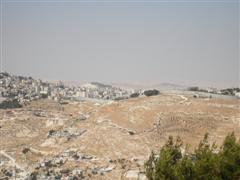 Also from this area, we observed
"the Wall" for the first time. It winds around in a very interesting way. The original plans for the wall literally divides
neighborhoods and families in half. The Jews are now finding themselves in a bind in may ways as the Arabs have appealed some of the
locations of the wall to Israeli high courts. In some cases the wall construction had to be stopped to await an appeal, and in other cases taken down and rerouted. It is not an easy solution, children are being separated from their
schools, cousins and families are separated, there is no easy solution. Also from this area, we observed
"the Wall" for the first time. It winds around in a very interesting way. The original plans for the wall literally divides
neighborhoods and families in half. The Jews are now finding themselves in a bind in may ways as the Arabs have appealed some of the
locations of the wall to Israeli high courts. In some cases the wall construction had to be stopped to await an appeal, and in other cases taken down and rerouted. It is not an easy solution, children are being separated from their
schools, cousins and families are separated, there is no easy solution.
Gadi remarked that Amy Beth has a lot of energy. Yeah, no kidding!
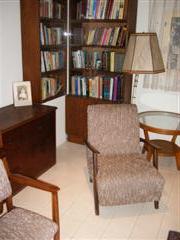 We toured the Menachem Begin Museum. The display was fantastic with multiple rooms of audio and video detailing the life and career of one of Israel’s most controversial leaders, and creator of the Likud party. He achieved peace between Israel and Egypt, but he had difficult times too. One of
Begin's plans was to push the Lebanese border back 40 km to prevent the rocket launches into local Israeli neighborhoods. Ariel Sharon pushed farther and basically overstepped his bounds. This led to a real war where there were many casualties. A slaughter of hundreds of Palestinians occurred when the Israelis let
a band of Christian fighters into the area. This caused a backlash against Begin who did bear the responsibility of this massacre. It eventually led him to resign as prime minister and he became reclusive for the remaining years of his life. I noticed that all of the important figures in Israeli politics had critical positions in the early stages of Israel’s development. We toured the Menachem Begin Museum. The display was fantastic with multiple rooms of audio and video detailing the life and career of one of Israel’s most controversial leaders, and creator of the Likud party. He achieved peace between Israel and Egypt, but he had difficult times too. One of
Begin's plans was to push the Lebanese border back 40 km to prevent the rocket launches into local Israeli neighborhoods. Ariel Sharon pushed farther and basically overstepped his bounds. This led to a real war where there were many casualties. A slaughter of hundreds of Palestinians occurred when the Israelis let
a band of Christian fighters into the area. This caused a backlash against Begin who did bear the responsibility of this massacre. It eventually led him to resign as prime minister and he became reclusive for the remaining years of his life. I noticed that all of the important figures in Israeli politics had critical positions in the early stages of Israel’s development.
Afterthought:
I hope history is not repeating itself...
The museum was beautiful, they even had the original furniture from Begin’s office and they even let us sit in the
original chairs, so of course, I did!
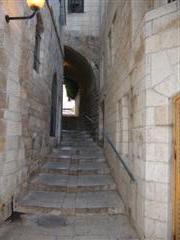 Amy Beth and I decided to spend our free evening in the Old City one last time. We tried to get lost and got some great “alleyway” type photos. I notice that there were no dead ends (I’m sure there are somewhere) and no matter what street you go down, there is always a staircase, or an archway, or alley way from which you can continue to move forward. Amy Beth and I decided to spend our free evening in the Old City one last time. We tried to get lost and got some great “alleyway” type photos. I notice that there were no dead ends (I’m sure there are somewhere) and no matter what street you go down, there is always a staircase, or an archway, or alley way from which you can continue to move forward.
We then went back to the Kotel for one more
visit before we would leave Jerusalem. As we were taking a few last
pictures of the wailing wall, Amy Beth noticed a car that pulled right up to the men's
entrance to the Kotel. A swarm of "black hats" surrounded
the car. Everyone was jockeying for a position to see who was
inside. An old man stepped out of the vehicle.
 "So,
who is he?" I asked (presumably) a yeshiva student who said,
"Rabbi Ungva." "Rabbi Ungva," I replied,
"who's that?" The yeshiva student replied, "a holy
man." Yeah, no kidding! I looked into his eyes and he looks ancient. He is a very frail old man, but you can see that he is considered very holy. They made room for him and he got up to the wall where he sat down and prayed. "So,
who is he?" I asked (presumably) a yeshiva student who said,
"Rabbi Ungva." "Rabbi Ungva," I replied,
"who's that?" The yeshiva student replied, "a holy
man." Yeah, no kidding! I looked into his eyes and he looks ancient. He is a very frail old man, but you can see that he is considered very holy. They made room for him and he got up to the wall where he sat down and prayed.
Note: As I was laying out this
website, I noticed that the picture that I chose (while looking at
thumbnails - not image names) for Rabbi Ungva (because it was the best
shot I had) was coincidentally picture #613, the number of mitzvot in the
torah. Now that's cool!
Update: I was
speaking with Rabbi Joseph Kolakowski of Kol
Emes Richmond today at the first night Shiva for Ernie Rosenthal on
6/3/09. I asked him if he knew of Rabbi Ungva. He thought it
might be the Rabbi from Ungvar (Hungary), or the Ungvar Rabbi. After
describing him we concluded he knew the rabbi to be Rabbi Menashe
Klein. Rabbi Kolakowski has even spent time with him and been to his
house. I searched the internet and found lots of material on Rabbi
Menashe Klein.
Not to go
unnoticed, this update (and post) took place on 6/3/09, please note how
close the 6/3 looks to 613. Every time that I come across Rabbi
Ungvar (now I know, Rabbi Menashe Klein) I have some connection to
613.
Another
coincidence? Maybe, but that's pretty damn cool!
 We tried to go to Rabbi Tzvi Ron’s yeshiva where he teaches for the second time, to see him, however he wasn’t there, and I was informed that he won’t be back until Tuesday, by that time, we will be in Tzefat. We observed the view of the Kotel from the vantage point of this yeshiva, and it really is a fantastic point of
view. His yeshiva is located right there at the front of the entrance to the
Kotel! We tried to go to Rabbi Tzvi Ron’s yeshiva where he teaches for the second time, to see him, however he wasn’t there, and I was informed that he won’t be back until Tuesday, by that time, we will be in Tzefat. We observed the view of the Kotel from the vantage point of this yeshiva, and it really is a fantastic point of
view. His yeshiva is located right there at the front of the entrance to the
Kotel!
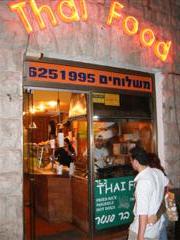 We then went to Jaffa street for dinner at a Thai
restaurant which was OK. We then saw a place where they had setup an enormous screen
(probably twice the size of the old Ridge Cinemas #1 screen) to watch the final game of the World Cup. There were thousands of spectators there to watch the game. At halftime, people who were there early enough to get a chair, were hoarding the seats for their friends and almost militant about giving them up. We saw an argument flair up between an Israeli woman, holding about seven seats, and three boys. In Israel, chivalry appears to be non-existent. If you are a woman, so what? We then went to Jaffa street for dinner at a Thai
restaurant which was OK. We then saw a place where they had setup an enormous screen
(probably twice the size of the old Ridge Cinemas #1 screen) to watch the final game of the World Cup. There were thousands of spectators there to watch the game. At halftime, people who were there early enough to get a chair, were hoarding the seats for their friends and almost militant about giving them up. We saw an argument flair up between an Israeli woman, holding about seven seats, and three boys. In Israel, chivalry appears to be non-existent. If you are a woman, so what?
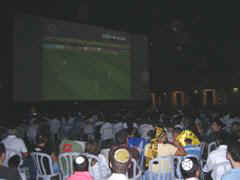 You serve in the military, you are virtually equal, so I think they figure, “why should I give my seat up for you?” In fact, Amy Beth asked several people for a seat, but was turned down each time. It wasn’t until there were about 10-15 minutes left in the game, when a yeshiva student gave his seat up for her. You serve in the military, you are virtually equal, so I think they figure, “why should I give my seat up for you?” In fact, Amy Beth asked several people for a seat, but was turned down each time. It wasn’t until there were about 10-15 minutes left in the game, when a yeshiva student gave his seat up for her.
Of course, we had been standing (and sitting on the ground) next to him for nearly an hour!
Most people were rooting against France. I was glad to see this, as the French are notorious for anti-Semitism.
We saw, the French star, Zidane's infamous head-butt. It was this
incident alone that seemed to turn the tide in Italy's favor. Italy won as
a result of a kick-off in overtime. Yeah!
After the game was over, we walked back with
Larry, Sam and Mike to the hotel.
[ Back ] [ Up ] [ Next ]
|